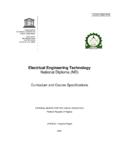Transcription of National Innovation Systems - OECD.org
1 National Innovation Systems ORGANISATION FOR ECONOMIC CO-OPERATION AND DEVELOPMENT. ORGANISATION FOR ECONOMIC CO-OPERATION. AND DEVELOPMENT. Pursuant to Article 1 of the Convention signed in Paris on 14th December 1960, and which came into force on 30th September 1961, the Organisation for Economic Co- operation and Development (OECD) shall promote policies designed: to achieve the highest sustainable economic growth and employment and a rising standard of living in Member countries, while maintaining financial stability, and thus to contribute to the development of the world economy;. to contribute to sound economic expansion in Member as well as non-member countries in the process of economic development; and to contribute to the expansion of world trade on a multilateral, non-discriminatory basis in accordance with international obligations.
2 The original Member countries of the OECD are Austria, Belgium, Canada, Denmark, France, Germany, Greece, Iceland, Ireland, Italy, Luxembourg, the Netherlands, Norway, Portugal, Spain, Sweden, Switzerland, Turkey, the United Kingdom and the United States. The following countries became Members subsequently through accession at the dates indicated hereafter: Japan (28th April 1964), Finland (28th January 1969), Australia (7th June 1971), New Zealand (29th May 1973), Mexico (18th May 1994), the Czech Republic (21st December 1995), Hungary (7th May 1996), Poland (22nd November 1996) and the Republic of Korea (12th December 1996). The Commission of the European Communities takes part in the work of the OECD (Article 13 of the OECD Convention).
3 OECD 1997. Permission to reproduce a portion of this work for non-commercial purposes or classroom use should be obtained through Centre Fran ais d'Exploitation du Droit de Copie (CFC), 3, rue Hautefeuille, 75006 Paris, France, for every country except the United States. In the United States permissions should be obtained through the Copyright Clearance Centre, Inc. (CCC). All other applications for permission to reproduce or translate all or part of this book should be made to OECD Publications, 2, rue Andr -Pascal, 75775 Paris Cedex 16, France. FOREWORD. Systemic approaches are giving new insight into innovative and economic performance in the OECD countries. technology -related analysis has traditionally focused on inputs (such as research expenditures) and outputs (such as patents).
4 But the interactions among the actors involved in technology development are as important as investments in research and development. And they are key to translating the inputs into outputs. The study of National Innovation Systems directs attention to the linkages or web of interaction within the overall Innovation system. An understanding of these Systems can help policy makers develop approaches for enhancing innovative performance in the knowledge-based economies of today. The smooth operation of Innovation Systems depends on the fluidity of knowledge flows among enterprises, universities and research institutions. Both tacit knowledge, or know-how exchanged through informal channels, and codified knowledge, or information codified in publications, patents and other sources, are important.
5 The mechanisms for knowledge flows include joint industry research, public/private sector partnerships, technology diffusion and movement of personnel. Identifying best practices for both the knowledge-based economy and National Innovation Systems is a focal point of OECD work in the field of science, technology and industry. This publication discusses the first phase of the work on National Innovation Systems and the attempt to develop indicators to map knowledge flows. Current work is focused on measuring institutional linkages, human resource flows, industrial clusters and innovative firm behaviour. This publication is part of the work of the Committee for Scientific and Technological Policy and is derestricted on the responsibility of the Secretary-General of the OECD.
6 3. TABLE OF CONTENTS. SUMMARY ..4. A. B. Rationale ..11. C. Policy KNOWLEDGE FLOWS IN National Innovation A. Joint industry B. Public/private interactions ..9. C. technology D. Personnel ANALYTICAL APPROACHES TO National Innovation . A. Innovation B. Cluster interactions ..26. C. International knowledge flows ..29. A. Policy implications ..41. B. Measurement issues ..42. C. Future 5. SUMMARY. The National Innovation Systems approach stresses that the flows of technology and information among people, enterprises and institutions are key to the innovative process. Innovation and technology development are the result of a complex set of relationships among actors in the system, which includes enterprises, universities and government research institutes.
7 For policy-makers, an understanding of the National Innovation system can help identify leverage points for enhancing innovative performance and overall competitiveness. It can assist in pinpointing mismatches within the system, both among institutions and in relation to government policies, which can thwart technology development and Innovation . Policies which seek to improve networking among the actors and institutions in the system and which aim at enhancing the innovative capacity of firms, particularly their ability to identify and absorb technologies, are most valuable in this context. The measurement and assessment of National Innovation Systems has centred on four types of knowledge or information flows: 1) interactions among enterprises, primarily joint research activities and other technical collaborations; 2) interactions among enterprises, universities and public research institutes, including joint research, co-patenting, co-publications and more informal linkages; 3) diffusion of knowledge and technology to enterprises, including industry adoption rates for new technologies and diffusion through machinery and equipment.
8 And 4) personnel mobility, focusing on the movement of technical personnel within and between the public and private sectors. Attempts to link these flows to firm performance show that high levels of technical collaboration, technology diffusion and personnel mobility contribute to the improved innovative capacity of enterprises in terms of products, patents and productivity. There are many different approaches to analysing National Innovation Systems . Firm-level Innovation surveys question enterprises on their sources of knowledge most relevant to Innovation and allow a ranking of different linkages by industrial sector and country. Cluster analysis focuses on the interactions between particular types of firms and sectors, which can be 7.
9 Grouped according to their technological and networking characteristics. Patterns of knowledge flows can differ markedly from cluster to cluster and also within countries specialised around different industrial clusters ( forestry, chemicals). Innovation Systems can also be analysed at different levels: sub-regional, National , pan-regional and international. While the National level may be the most relevant due to the role of country-specific interactions in creating a climate for Innovation , international technology flows and collaborations are taking on growing significance. Future research will focus on improving the indicators used to map interactions in National Innovation Systems as well as the linkages to the innovative performance of firms and countries.
10 These indicators are at an early stage of development and do not approach the robustness of more conventional measures such as R&D expenditures. A main goal is to improve the comparability of studies across countries by encouraging those engaging in analysis of Innovation Systems to focus first on measuring a core set of knowledge flows using similar indicators. At the same time, specific analyses will be directed to deepening the understanding of certain types of flows in National Innovation Systems , namely: 1) human resource flows;. 2) institutional linkages; 3) industrial clusters; and 4) innovative firm behaviour. 8. INTRODUCTION. A. Definition Analysis of technology performance and policies has traditionally focused on inputs (such as expenditures on research and development and the number of research personnel) and outputs (such as patents), the measurement of which is standardized across OECD countries (OECD, 1996a).












